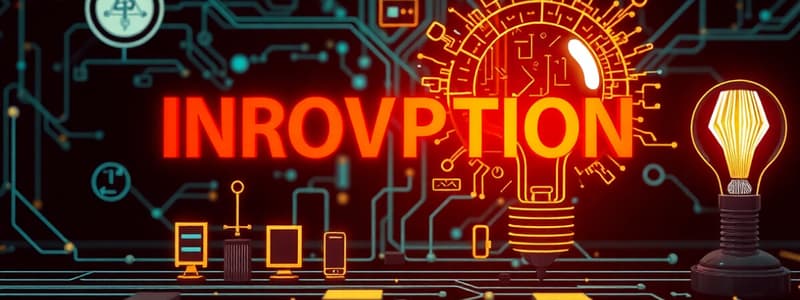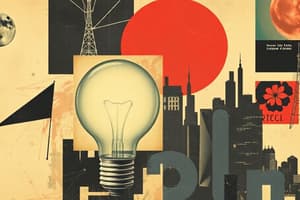Podcast
Questions and Answers
Which of the following is NOT a technique for managing resistance to change?
Which of the following is NOT a technique for managing resistance to change?
- Participation
- Facilitation and Support
- Education and Communication
- Resource Allocation (correct)
What is the key difference between creativity and innovation?
What is the key difference between creativity and innovation?
- Creativity is a personal trait, while innovation is a team effort.
- Creativity is a mental process, while innovation is a physical process.
- Creativity involves generating ideas, while innovation is the practical application of those ideas. (correct)
- Creativity is a subjective process, while innovation is a measurable outcome.
Which of the following is NOT a form of innovation listed in the text?
Which of the following is NOT a form of innovation listed in the text?
- Applied research
- Curiosity-driven research
- Research and development
- Market research (correct)
Which of the following is NOT a structural factor that encourages innovation?
Which of the following is NOT a structural factor that encourages innovation?
What does "throw the bunny" refer to in the context of Mattel's culture?
What does "throw the bunny" refer to in the context of Mattel's culture?
Which type of personality is most likely to experience stress due to their urgency and competitiveness?
Which type of personality is most likely to experience stress due to their urgency and competitiveness?
Which of the following is NOT a type of stressor discussed in the text?
Which of the following is NOT a type of stressor discussed in the text?
Which of the following statements accurately describes the difference between internal managers and external consultants in managing change?
Which of the following statements accurately describes the difference between internal managers and external consultants in managing change?
What best defines disruptive innovation?
What best defines disruptive innovation?
Which of the following historical examples illustrates disruptive innovation?
Which of the following historical examples illustrates disruptive innovation?
What is a key difference between sustaining and disruptive innovation?
What is a key difference between sustaining and disruptive innovation?
Why are established companies often vulnerable to disruptive innovation?
Why are established companies often vulnerable to disruptive innovation?
Which of the following statements about resistance to change is true?
Which of the following statements about resistance to change is true?
What can lead to the failure of well-known companies in the face of disruptive innovation?
What can lead to the failure of well-known companies in the face of disruptive innovation?
Which of the following innovations was initially overlooked but later widely adopted?
Which of the following innovations was initially overlooked but later widely adopted?
Why might smaller businesses be more adept at innovation compared to larger companies?
Why might smaller businesses be more adept at innovation compared to larger companies?
Which of the following is NOT a force driving change within organizations?
Which of the following is NOT a force driving change within organizations?
What is the main takeaway for entrepreneurs from the example of Tesla?
What is the main takeaway for entrepreneurs from the example of Tesla?
What is the primary difference between the Calm Waters and White-Water Rapids metaphors of change?
What is the primary difference between the Calm Waters and White-Water Rapids metaphors of change?
Which of these is an example of how economic change can necessitate organizational adaptation?
Which of these is an example of how economic change can necessitate organizational adaptation?
What is the purpose of creating autonomous teams or "skunk works" within large organizations?
What is the purpose of creating autonomous teams or "skunk works" within large organizations?
Which of these is NOT a key category of organizational change?
Which of these is NOT a key category of organizational change?
How can managers effectively address the challenges of workforce composition changes?
How can managers effectively address the challenges of workforce composition changes?
What is a change agent in the context of organizational change?
What is a change agent in the context of organizational change?
Flashcards
Organic Structures
Organic Structures
A characteristic of organizational structures that encourages collaboration across different departments, fostering innovation.
Creativity
Creativity
The ability to generate new and unique ideas, a foundational step in the innovation process.
Innovation
Innovation
Applying creative ideas in practical ways to develop novel products, processes, or solutions.
Role Conflicts
Role Conflicts
Signup and view all the flashcards
Role Overload
Role Overload
Signup and view all the flashcards
Role Ambiguity
Role Ambiguity
Signup and view all the flashcards
Type A Personality
Type A Personality
Signup and view all the flashcards
Participation in Change Management
Participation in Change Management
Signup and view all the flashcards
Disruptor
Disruptor
Signup and view all the flashcards
Digital Disruption
Digital Disruption
Signup and view all the flashcards
Opportunity for Entrepreneurs
Opportunity for Entrepreneurs
Signup and view all the flashcards
Skunk Works for Innovation
Skunk Works for Innovation
Signup and view all the flashcards
Change Management
Change Management
Signup and view all the flashcards
Forces Driving Change
Forces Driving Change
Signup and view all the flashcards
Technological Change: Adaptation
Technological Change: Adaptation
Signup and view all the flashcards
Types of Organizational Change
Types of Organizational Change
Signup and view all the flashcards
Disruptive Innovation
Disruptive Innovation
Signup and view all the flashcards
Sustaining Innovation
Sustaining Innovation
Signup and view all the flashcards
Creative Destruction
Creative Destruction
Signup and view all the flashcards
Resistance to Change
Resistance to Change
Signup and view all the flashcards
Disruptive Advantage of Smaller Businesses
Disruptive Advantage of Smaller Businesses
Signup and view all the flashcards
Overlooked Innovation
Overlooked Innovation
Signup and view all the flashcards
Vulnerability of Established Companies
Vulnerability of Established Companies
Signup and view all the flashcards
Disruptive Dynamics
Disruptive Dynamics
Signup and view all the flashcards
Study Notes
Disruptive Innovation
- Refers to innovations that significantly alter an industry's competitive landscape.
- Typically originates from smaller companies targeting underserved markets with cheaper alternatives.
- Often associated with "creative destruction," replacing outdated technologies with superior ones.
Historical Examples
- Railroads replaced sailing ships.
- Telephones replaced telegraphy.
- Automobiles replaced horse-drawn carriages.
Sustaining vs. Disruptive Innovation
- Sustaining Innovation: Incremental improvements to existing products/services (e.g., high-definition TVs, fingerprint recognition).
- Disruptive Innovation: Fundamental changes replacing entire industries (e.g., new technologies or business models).
Importance of Disruptive Innovation
- Success can lead to failure: Established companies may become complacent and vulnerable to disruption.
- Resistance to change: Established companies can view disruptive ideas as threats to their market power.
Vulnerable Businesses
- Established companies are at greater risk of disruption due to existing investments.
- Smaller companies often demonstrate greater agility and innovation.
Examples of Disruptive Innovation
- Xerox' inventions (computer mouse, GUI) were later widely adopted.
- Failed disruptive innovations like BlackBerrys, Segways, and Google Glass.
Implications for Entrepreneurs and Managers
- Innovative individuals can capitalize on opportunities with simpler, more affordable alternatives.
- Large organizations should create autonomous teams (skunk works) for innovation.
Management of Organizational Change
- Change is an inherent aspect of organizational life.
- Forces driving change include pandemics, changing consumer preferences, new regulations, and technological advancements.
Technological Change
- Technological advancements compel entire industries to adapt (e.g., streaming services like Netflix).
Types of Organizational Change
- Economic Change: Shifts in labor markets and economic conditions impacting companies.
- New Organizational Strategies: Changes in business strategies necessitate operational shifts.
- Workforce Composition Changes: Diversity necessitates adapting to different work preferences.
- New Technology: Groundbreaking innovations impact entire industries (e.g., 3-D printing).
- Changing Employee Attitudes: Significant changes can lead to employee stress and resistance.
Metaphors of Change
- Calm Waters Metaphor: Change is a three-step process (unfreezing, changing, refreezing) in a stable environment.
- White-Water Rapids Metaphor: Represents the chaotic and continuous nature of change.
Types of Change Agents
- Internal Managers: Deeper understanding of company culture, can be cautious.
- External Consultants: Objective perspectives, may lack familiarity with history.
Techniques for Managing Resistance to Change
- Education and Communication: Keeping employees informed about the reasons behind changes.
- Participation: Involving employees in decision-making for fostering commitment.
- Facilitation and Support: Providing resources to help employees navigate change.
- Negotiation: Offering incentives for buy-in.
- Manipulation and Co-optation: Subtle tactics to manage resistance.
- Coercion: Forceful methods for change.
Creativity and Innovation
- Creativity: Generating unique ideas.
- Innovation: Practical application of creative ideas.
- Adaptability: Necessary organizational trait to anticipate changes.
Forms of Innovation
- Curiosity-driven research.
- Applied research.
- Research and development.
Structural and Cultural Variables for Innovation
-
Structural Factors:
- Organic structures encourage collaboration.
- Ample resources are critical.
- Supportive communication bridges gaps.
- Fostering creative outcomes through minimizing time pressures.
-
Cultural Characteristics:
- Acceptance of ambiguity and risk-taking.
- Creating a culture that embraces failures.
- Encouraging experimentation.
Employee Stress
- Stress negatively impacts individuals when facing high demands, constraints, or opportunities.
- Types of Stressors:
- Role conflicts.
- Role overload.
- Role ambiguity.
Personality Types and Stress
- Type A Personality: Characterized by urgency and competitiveness.
- Type B Personality: More relaxed approach to time and achievement.
Studying That Suits You
Use AI to generate personalized quizzes and flashcards to suit your learning preferences.




